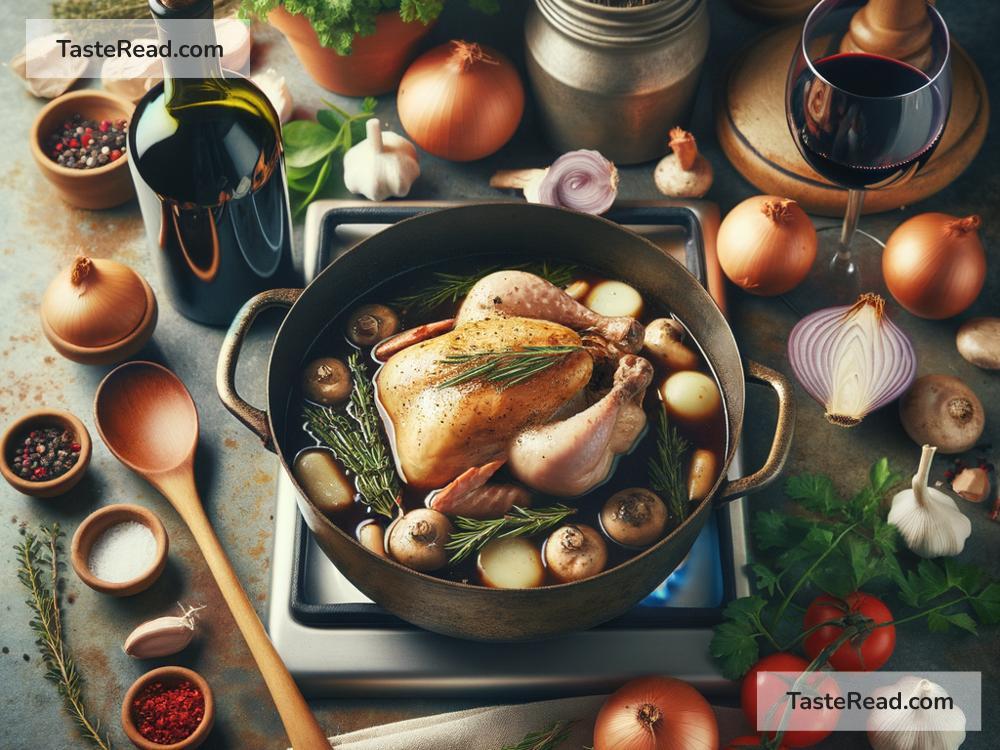The Evolution of the French Coq au Vin
French cuisine is famous for its rich flavors, attention to detail, and connection to tradition. One of the dishes that perfectly represents these qualities is Coq au Vin, which translates to “Rooster in Wine.” This beloved recipe has been passed down through generations and continues to delight food lovers across the world. Today, we’ll explore the fascinating journey of Coq au Vin and how it has evolved over time.
Humble Beginnings
Coq au Vin has its origins in the French countryside. In the early days, the dish was not considered luxurious or fancy. Instead, it was a practical way for farmers and villagers to turn tough, older roosters into something flavorful and tender.
Back then, chickens and roosters were raised for eggs and breeding rather than for meat, so by the time they were cooked, the birds were often older and had tough, sinewy meat. French cooks, known for their ingenuity, found a solution. They would marinate the rooster in red wine for hours or even days to break down its fibers and tenderize the meat. The alcohol and acidity in the wine worked miracles on the bird, making even the toughest cuts easier to chew, while also infusing the dish with deep flavors.
Alongside the meat and wine, they added simple ingredients like onions, garlic, and herbs to create a hearty stew. This was no lavish feast—it was rustic cooking at its best, relying on readily available foods and resourceful techniques.
Roman Influence
There’s some debate about the exact origin of Coq au Vin, but many believe its roots trace back to ancient Rome. Legend has it that Julius Caesar once received a rooster from a local village as a symbolic gift. To make the rooster edible, they cooked it slowly in wine, a drink loved by the Romans. While this story may be more myth than fact, it highlights how the practice of braising meat in wine was already common in Europe centuries ago.
As Romans expanded their empire, such cooking methods likely spread throughout France. Over time, the French perfected the technique, adding their own flair and ingredients to make it uniquely theirs.
Classic French Cooking
During the Middle Ages, dishes like Coq au Vin became firmly rooted in French culinary traditions. By the 19th century, these recipes were refined and written down by cooking experts like Auguste Escoffier, who is often credited with modernizing French cuisine.
Despite these developments, Coq au Vin remained a home-cooked favorite rather than a dish served in elite restaurants. This speaks to its humble origins: it wasn’t flashy or expensive, but instead a comforting meal that nourished families during chilly evenings.
It wasn’t until later that Coq au Vin gained widespread international appeal, in large part thanks to television chef and cookbook author Julia Child. In her famous book Mastering the Art of French Cooking (1961), Julia introduced Coq au Vin to American audiences, showcasing her love for the dish and French cuisine as a whole. With her enthusiastic spirit, she taught people the joy of braising meat and sipping wine along the way.
Regional Variations
France is known for its unique regional foods, and Coq au Vin is no exception. While the traditional version uses red Burgundy wine, different parts of France have put their own spin on the dish.
For example, in Alsace, Coq au Vin is made with white wine instead of red, giving it a brighter and lighter flavor profile. In Champagne, it’s cooked with—you guessed it—Champagne, adding a touch of luxury. In Provence, chefs might add local herbs like thyme and rosemary, alongside tomatoes for a Mediterranean twist. Each variation reflects the personality of the region where it’s made, further demonstrating how adaptable this dish can be.
Modern-Day Coq au Vin
Today, you don’t need to track down an old rooster to enjoy Coq au Vin. Most recipes swap the rooster for a common chicken, which is easier to find and much less time-consuming to cook. Modern cooks have adjusted the recipe to fit busy lifestyles, shortening the marination time and streamlining the steps while retaining the complex flavors that make the dish special.
In restaurants around the world, chefs often elevate Coq au Vin with gourmet touches. They might serve it with fancy sides like truffle mashed potatoes or crisp baguette slices. It’s a dish that can feel both rustic and refined, allowing it to shine in any setting.
The Heart of Tradition
No matter how much Coq au Vin evolves, it stays true to its roots: a dish born out of creativity and resourcefulness. It’s a recipe that demonstrates how wine doesn’t just pair with food—it can be part of the cooking process, unlocking new dimensions of flavor.
For many, Coq au Vin goes beyond nourishment. It’s about sharing a meal, savoring every bite, and celebrating the long history of French cooking. Whether it’s prepared in a rural farmhouse or a modern kitchen, this timeless classic reminds us of the beauty in simple, well-made food.
So, whether you’re trying it for the first time or revisiting an old favorite, Coq au Vin brings a taste of tradition to your table, connecting you both to history and to the joys of cooking. Bon appétit!


